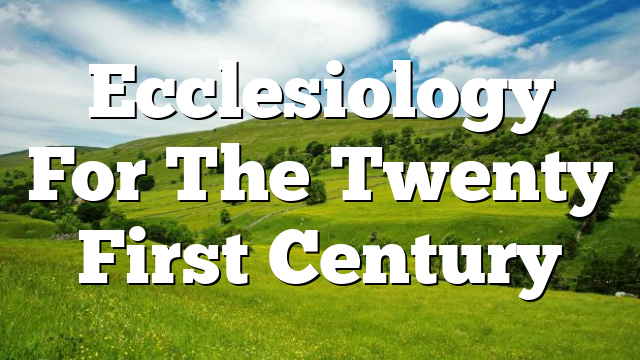Click to join the conversation with over 500,000 Pentecostal believers and scholars
Click to get our FREE MOBILE APP and stay connected
| PentecostalTheology.com



142 book reviews Cheryl M. Peterson Who is the Church: An Ecclesiology for the Twenty-first Century(Minneapolis, mn: Fortress Press, 2013). viii + 153 pp. $22.00 paperback. Cheryl Peterson is a Lutheran minister and Associate Professor of systematic theology at Trinity Lutheran Seminary, Columbus, Ohio. This work is a revision of the doctoral dissertation she submitted to Marquette University in 2004. Like the original dissertation the main target of this book is Lutheranism. The book argues that in the face of dwindling membership in mainline Protestant churches, these churches have been looking for solutions to this crisis in all the wrong places. They have been asking what they ought to do in order to fill their pews, thus focusing on programs and techniques of church growth. These church communities fail to realize that the dwindling membership crisis is not one that may be effectively addressed through such techniques, but rather through clarifying the identity of the church. The question the churches should be asking is not what they should be doing in orderto increasethe membership; rather, they should be asking the ontological question concerning the nature of the church: they should be asking “who is the church?” and not “what shall the church do?” (p. 4). The church should be concerned with clarifying its theological identity rather than with programs and growth. It is critical for the church to clarify its theological identity, because the mainline Protestant churches in America emerged in a historical context that led Christians to forget the identity of the church. Thus, the book engages both the historical and theological background of mainline Protestant churches in America in its bid to define who the church is. The book is made up of an introduction, six chapters, and an epilogue. Each chapter ends with questions for reflection and discussion. The questions at the end of each chapter and the epilogue, which give “a vision for revival,” suggest that the book is not meant to be read only in academic circles but in local churches as well. In order to address the identity crisis of mainline Protestantism in America, Peterson probes the historical background of these churches. By doing this, she discovers that these churches developed in a context in which the church was used to fund various aspects of American culture, especially the idea of “Christian America” and American idea of progress. To her, the church came to be anchored in a Christendom mentality in which the church was influential in society. What is happening now is that the influence that the church had in society is waning so that mainline Protestants are becoming “‘sidelined’ churches” (p. 2). This sidelining of mainline Protestantism is what she calls the “disestab- lishment of the churches” (pp. 29–30), and this disestablishment has caused © koninklijke brill nv, leiden, 2015 | doi: 10.1163/15700747-03701012 ========1========book reviews 143 much anxiety about the survival of these churches. Compounding the identity crisis is the fact that the mainline churches came to understand themselves as voluntary associations, which individuals chose to join. Both the appro- priation of the church to fund a “Christian America” project and the percep- tion of the church as voluntary organizations were theologically problematic. These theologically problematic perceptions of the church could be seen as standing at the heart of the ecclesial identity crisis in America. Only a rig- orous theological account of the church could begin to address this identity crisis. To develop an adequate theological account of the church for the twenty- first century, Peterson teases out some ecclesiologies, beginning with the Ref- ormation understanding of the church as Word-event (that is the church as creation of the Word of God) she also revisits the understanding of the church as communion and contemporary missional ecclesiologies. She points out that while these ecclesiogies contain useful elements, a more adequate ecclesiol- ogy for our time needs to begin with a pneumatological narrative, the nar- rative of the church as the creation of the Spirit of God, as found in Acts 2. Drawing from the narrative in Acts 2 and the ecumenical creeds of the early church, Peterson defines the church as “a Spirit-breathed people who are formed by word and sacrament around which they gather weekly to become a koinonia of sharing and healing … a Spirit-breathed people who are sent into the world to share God’s forgiveness and koinonia with a hurting and brokenworld”(p.147).RatherthanviewingitselfasintendedtofundaChristian America project or as voluntary associations, the church should be viewed as a people formed and sent by the Spirit to participate in the mission of God (missio Dei) in and for the world. It is living out this theological understanding of the church as people of the Spirit that should motivate the church’s quest for revival. Appropriating the vision of the church as a creation of the Spirit is certainly needful, especially in the context of mainline American Protestantism that has sometimes viewed the Spirit with suspicion. This book should therefore be read not only by students and professors of theological colleges and divinity schools, but also by churches seeking a vision for revival. However, given that such revival is already taking place in Pentecostal churches in America and around the world, one would have thought that an ecclesiology that begins with the Spirit would engage Pentecostal ecclesiology. Even though Peterson points out that her engagement of the ecumenical creeds of the early church distinguishes her pneumatological ecclesiology “from a more traditional Pente- costal approach” (p. 10) it is not clear how this is the case particularly because PNEUMA 37 (2015) 111–171 ========2========144 book reviews Pentecostal theologians have been appropriating these creeds for some time now. David Tonghou Ngong Assistant Professor of Religion and Theology, Stillman College, Tuscaloosa, Alabama Dngong@stillman.edu or dvdngng@yahoo.co.uk PNEUMA 37 (2015) 111–171 ========3========




Most Talked About Today